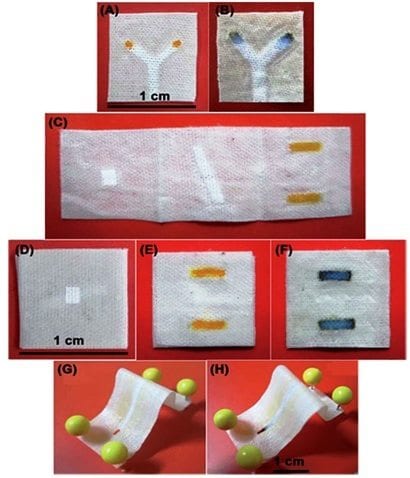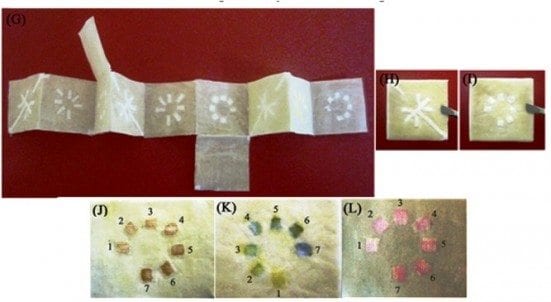1. Introduction
Microfluidic science studies the phenomena and mechanism of fluid flow and control at very small volume, i.e. in the range of lower than or equal to microliters. At this volume, the fluid behaves as laminar flow, rather than in turbulent way as if it were in large volume.
Microfluidic has wide application for analytical chemistry, the science of detecting or measuring presence of certain analytes in a sample. In the medical world, the use of microfluidic will enable diagnostic to be carried out at lower sample volume, hence lower cost and quicker response time, as well as less painful to the subjects.
Conventionally devices that utilize microfluidic principles were made using fabrication techniques borrowed from microelectronic micromachining technology. This technology includes photolithography, deposition, and etching. This technology is usually implemented using silicon, glass or polymer materials. While its use in microfluidic is quite versatile, yet the development cost is quite high, especially for prototyping purpose. Furthermore, the materials used in this technology are also not suitable for point of care analysis where low-cost, flexible (and even wearable), disposable, bio-degradable materials are preferred.
2. Research Challenge
To provide solutions for real-world problem, especially related to diagnostics in the medical world, microfluidic device needs to be made using low-cost fabrication techniques which are scalable from prototyping to mass production. Furthermore, new materials need to be employed that are sustainable, easily obtainable, hence assuring its low-cost, and also flexible to ensure high mechanical durability which is required in field diagnostic applications. The material should also be easily disposable, preferably bio-degradable so that it is also environmentally-friendly.
3. Context
I started working at UTM in July 2010. I did my PhD in Microelectronics (Microelectromechanical System – MEMS) at the TU Delft, the Netherlands, and did also post-doctoral research in micro-optics integration for dental drill bit at the same university. When I came to UTM, Malaysia, such advanced microelectronics fabrication technology is hardly available at UTM. Even perhaps only MIMOS has such facilities but with limited access or costly use access. Therefore at that time we thought that we needed to use technologies that are already widely available in Malaysia, preferably indigenous ones. The materials themselves need not be indigenously obtained in Malaysia, but should be easily obtainable at low cost.
4. Our Solution
We thought then about using Batik techniques that are already widely used for textile materials and industries. Batik techniques rely on the use of wax to draw hydrophobic pattern onto fabrics. Dyes are then soaked and absorbed into the un-waxed hydrophilic parts of the fabric. Instead of soaking, when fluid is applied at one part of the hydrophilic part, its wicking could be carefully controlled by patterning the appropriate wax hydrophobic barrier. Hence batik and fabric, e.g. cotton can be used as alternative technique and materials for fabricating microfluidic devices.
5. What was the impact/to whom the impact goes/How does its existence benefit the community.
The use of batik and cotton fabric will make microfluidics device lower in cost, at prototyping stage and at mass-scale production. At proof of concept stage, the device can be fabricated using direct writing of the wax similar to batik tulis technique. At larger scale production, the device can be fabricated using stamp technique, similar to batik cap technique. For amateur batik designer, like most of us engineer, the patterning can be done with the help of Computer-Aided-Design software, to print the pattern on a paper first, before subsequent wax transfer to fabric.
The use of cotton fabric as the platform material will also make the microfluidic device more sustainable and environmentally friendly. Cotton is widely available as natural textile material. It is also disposable since it is biodegradable. Furthermore, cotton fabrics are also flexible and mechanically durable material that can withstand mechanical disturbance upon packaging and transporting of the device.
Since batik-inspired wax-patterning and cotton fabric is lower cost in general to fabricate and produce microfluidic analytical device, this will promote wider use of microfluidic analytical device in the society, especially for the purpose of point-of-care diagnostic. Eventually, this can create lower cost health care for the society in general since disease can be early detected at the user/laymen level without the need of expensive instrumentation and highly skilled operator.
In the economic sector, if the fabrication of such devices can be integrated with the already existing batik craft industry, this can add further values to the already existing traditional craft industry.
The use of cotton fabrics which are flexible and wearable also gives birth to new range of wearable microfluidic devices; analytical devices that can be embedded into conventional sanitary products, e.g. baby pampers, sanitary napkin, etc.
By : Dr. Deddy Hermawan Bagus Wicaksono
dedy.wicaksono@biomedical.utm.my



